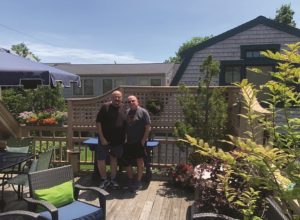PROVINCETOWN — Early in the morning of June 11, seven Provincetown residents received the email that every renter here fears: “It’s been wonderful being your landlord, but I’m getting older and I need to retire. The real estate photographer will be there at 3 p.m. today.”
The seven residents of the six units at 28-32 Standish St. were fortunate to have annual leases through Sept. 30, which gave them almost four months to look for new homes. The last two times this happened to him, said Dan McKeon, he was told to leave within 30 days.

“When I lived on Center Street, the notice came Memorial Day weekend of 2014, and then on Nelson Avenue, the notice came Memorial Day weekend of 2016,” said McKeon. Tourist traffic isn’t just good for restaurants and bars — a summertime listing helps sell a house as well.
Landlords retire all the time, and it’s their right to do so. The sale of individual properties is significant because of what’s happening in the aggregate.
When rental housing sells on the Outer Cape, it rarely stays a year-round rental. The potential income from short-term rentals is so high — more than double the return from renting year-round, according to a 2018 UMass Dartmouth study — that it has elevated the price of real estate far beyond what most local residents can pay.
Census data show that the privately owned landlord-tenant rental market is melting away.
500 Rental Units Lost
In 2000, the U.S. Census recorded 3,890 residential units in Provincetown, almost exactly evenly divided between “occupied housing units” and “for seasonal, recreational, or occasional use.” The “occupied housing” column showed 988 owner-occupied units, and 849 renter-occupied units.
By the 2010 census, Provincetown’s total residential inventory had increased by 463 units. Yet the number of occupied units had fallen — and the loss was entirely in the renters’ column: there were only 565 renter-occupied units that year.
The 2019 American Community Survey estimated that there were still fewer occupied units than in 2010. Of 1,570 occupied units, only 334 were renter-occupied.
Just over 100 new affordable units were constructed between 2000 and 2017, according to the UMass Dartmouth report — most of them at Province Landing and Stable Path. Even so, the total rental inventory shrank by 515 units over 19 years. The entire rental housing stock is only 40 percent of what it was in 2000 — and the numbers are going down.
On Standish Street
The residents at 28-32 Standish St. are a microcosm of the town. House painter Annemarie Piccerelli moved to Provincetown in 1982. Allan Lukauskas moved here in 2002, and recently retired for medical reasons. Chris Racine is a manager and DJ at the Crown & Anchor. Dan McKeon is an event photographer for the Provincetown Business Guild and Provincetown Magazine. Other residents work at Victor’s restaurant, Napi’s restaurant, and the Boatslip Resort.
Piccerelli said she has moved four times in the last three years. McKeon moved to Standish Street in 2016, and Lukauskas began renting in 2010.
All three said they like and respect their landlord, and they like their apartments. They approached Michelle Jarusiewicz, the town’s housing specialist, to find out if there was anything they could do to preserve the units as year-round rentals.
“She said there’s nothing the town can do,” said Piccerelli. “There’s no money in the housing trust. I said, ‘Where is all the money from the short-term rental tax?’ That money should go to the year-round housing trust. Forget about tourism — they have enough.”
Piccerelli is referring to the $2 million Provincetown received in the fiscal year that ended June 30, 2021 from the expansion of the rooms tax to short-term rentals. According to Provincetown’s existing allocation formula, 35 percent of that money went to the tourism fund. None of it went to a housing fund.
“I said to Michelle, ‘This is the type of property the town needs to save,’ ” said Piccerelli. “It’s going to be six more empty condos.”
Piccerelli wants the town to approach the landlord, Marilyn Mervar Rodes, and ask if the house could be sold at a reasonable price and the rental units preserved. She believes that Rodes has an attachment to Provincetown. “She’s been here since the ’70s,” Piccerelli said.
What Can Be Done?
The town does not have $3 million set aside to buy six units of housing. That’s the asking price for 28-32 Standish St. But there are alternatives to buying the property outright.
Nantucket is exploring two approaches, according to Housing Director Tucker Holland. One is a trust that would buy the land underneath a residential property, add a deed restriction guaranteeing year-round occupancy, and then sell just the building at a lower price. This would make residential units substantially cheaper and would give the town a permanent seat at the table for future transactions, according to Holland.
Nantucket is also considering paying a large developer to deed-restrict 78 new units to year-round-occupancy only, said Holland. The developer of the Surfside Crossing project has already offered to make 25 percent of the 156 units affordable rental housing, and another 25 percent deed-restricted year-round-only market-rate condos. Without potential revenue from short-term rentals, those condos are expected to sell at rates much closer to the working income of island residents.
Holland is also considering making an offer to the developer to secure year-round-only deed restrictions on the other 78 market-rate condos in the project. It is not common to use public money this way, said Holland, but for resort towns where the appetite for short-term rentals seems endless, new strategies have to be carved out.
“A year-round-only deed restriction with no income restriction associated with it — this is kind of new ground,” said Holland. “We’re really talking about creating a bifurcated market, with a pool of year-round-only properties.”
Laura Shufelt is a Cape Cod native and resident who is director of community assistance at the Boston-based Mass. Housing Partnership, and an expert on appropriate uses of public funds and fair housing. The Independent asked her about the use of public money for year-round-only deed restrictions.
“For buying down to affordable-ownership opportunities, we know how to do that,” said Shufelt. “There’s a formula. For affordable rentals, it depends on the funding source, but you’ll see towns negotiate with a developer to secure more affordable units in a mixed-use development. You figure out what rental schedule you’re buying down to, and then the developer still owns it. You’ve paid for the deed restriction, but you haven’t bought the units.
“For existing units with existing tenants,” Shufelt went on, “it’s more difficult, but I think it’s viable.” This kind of arrangement is “on everyone’s list of things they’d like to do,” she added.
“It’s certainly less money than building a new unit,” Shufelt said. “The investment is less, and you’re getting a great value, but also, you’re getting what you need to sustain the community.”
How much might it cost to deed-restrict a property to year-round-only use? Both Holland and Shufelt were unsure but said it could be roughly calculated against the income lost due to the restriction. Leaving the rents at market rate would be a cheaper restriction than buying them all the way down to an officially “affordable” level, Shufelt said.
What this option comes down to, Shufelt said, is “a negotiation.” And that would depend on what owners think is fair.
“There are some people that, in a tight community like Provincetown, want to maintain the culture,” said Shufelt. “They want to maintain the town for what it’s been. And it can’t happen if someone doesn’t step forward.”

 The possibilities posted are tantalizing but often impractical — someone advertised a house swap: you get to stay in their Boulder, Colo. home for a few months in exchange for letting them stay in your Provincetown abode. Selfies are captioned with biographical information. One person is the proud owner of “a small deaf chihuahua”; another is a floral photographer; and, despite the boa he’s wearing in his picture, a third notes he is straight. Most are requests for housing. “Likes” often correspond to good looks.
The possibilities posted are tantalizing but often impractical — someone advertised a house swap: you get to stay in their Boulder, Colo. home for a few months in exchange for letting them stay in your Provincetown abode. Selfies are captioned with biographical information. One person is the proud owner of “a small deaf chihuahua”; another is a floral photographer; and, despite the boa he’s wearing in his picture, a third notes he is straight. Most are requests for housing. “Likes” often correspond to good looks.